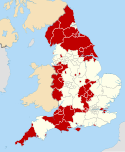History
York was an ancient borough, which held city status from time immemorial. In 1396 the city was given the right to appoint its own sheriffs, making it a county corporate, outside the jurisdiction of the Sheriff of Yorkshire. [3] In 1449 an adjoining rural area called the Ainsty, covering several villages to the south-west of York, was brought under the city's authority. [4]
By the nineteenth century the city corporation's powers were deemed inadequate to deal with the challenges of providing and maintaining the infrastructure of the city. A separate body of improvement commissioners was established in 1825 to pave, light and repair the streets, provide a watch, and supply water. [5] [6]
York was reformed in 1836 to become a municipal borough under the Municipal Corporations Act 1835, which standardised how many boroughs operated across the country. The city was then governed by a body formally called the "lord mayor, aldermen and citizens of the city of York", generally known as the corporation or city council. [7] Shortly afterwards the question arose as to whether the reformed corporation's area still included the Ainsty. This was resolved later in 1836 when the Municipal Corporation (Boundaries) Act 1836 confirmed that the municipal boundaries only covered the city proper, and the Ainsty was transferred to the West Riding. [8]
The improvement commissioners continued to exist alongside the reformed corporation until 1850, when the city was also made a local board district with the city council acting as the local board, thereby taking over the responsibilities of the abolished commissioners. [9]
The city's municipal boundaries were enlarged on a number of occasions, notably in 1884 when it gained areas including Clifton and Heworth, and in 1937 when it gained areas including Acomb, Dringhouses and Middlethorpe. There were more modest adjustments to the boundaries in 1934, 1957 and 1968. [10] [11]
When elected county councils were established in 1889 under the Local Government Act 1888, York was considered large enough to provide its own county-level services and so it was made a county borough, independent from the three county councils established for the surrounding East Riding, North Riding and West Riding. [12] For lieutenancy purposes York was deemed part of the West Riding. [13]
York was reconstituted as a non-metropolitan district in 1974 under the Local Government Act 1972. As part of those reforms, the city was placed in the new non-metropolitan county of North Yorkshire, with the city council ceding county-level functions to the new North Yorkshire County Council. The city retained the same boundaries at the time of the 1974 reforms. [14]
In 1996, following a review under the Local Government Act 1992, the district was replaced by a unitary authority with significantly larger boundaries, gaining a number of civil parishes from the neighbouring districts of Harrogate, Ryedale and Selby. Some of these parishes were already effectively suburbs, having been absorbed into the city's urban area since the boundaries had last been reviewed in 1968; others formed part of the rural hinterland around the city. The reforms included the creation of a new non-metropolitan county of York covering the same area as the enlarged district, but with no separate county council; instead the district (city) council took on county functions, making it a unitary authority. [15] The city remains part of the wider ceremonial county of North Yorkshire for the purposes of lieutenancy. [16]
Local government across North Yorkshire was reviewed again in 2023, when North Yorkshire County Council also became a unitary authority, and rebranded itself as North Yorkshire Council. As part of the process leading up to those reforms various alternatives were considered, some of which would have divided North Yorkshire into smaller unitary authorities which could have included York, but these alternatives were ultimately rejected. [17] [18] [19] [20]
Instead, a combined authority was established in 2024 covering York and North Yorkshire, called the York and North Yorkshire Combined Authority. It is chaired by the directly elected Mayor of York and North Yorkshire. [21] [22]






